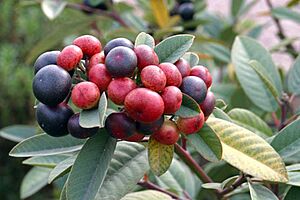California coffeeberry facts for kids
Quick facts for kids California coffeeberry |
|
|---|---|
 |
|
| Conservation status | |
| Scientific classification | |
| Genus: |
Frangula
|
| Species: |
californica
|
| Synonyms | |
|
Rhamnus californica Eschsch. |
|
Frangula californica is a plant that used to be called Rhamnus californica. It is a type of flowering plant in the buckthorn family. This plant grows naturally in western North America. It produces fruits and seeds that can be eaten. People often call it California coffeeberry or California buckthorn.
Contents
Where Does It Grow?
This plant is native to California, the Southwestern United States, and the Baja California state in Mexico. It has also been brought to Hawaii.
You can find California coffeeberry in places like oak woodlands and chaparral areas. Some of these plants can live for a very long time, possibly between 100 and 200 years!
What Does It Look Like?
Frangula californica is usually a shrub that grows about 3 to 12 feet (1 to 3.6 meters) tall. It can look a bit different depending on where it grows. If conditions are good, it might even grow into a small tree taller than 12 feet (3.6 meters). But most of the time, it's a shrub about 3 to 6 feet (1 to 1.8 meters) tall.
Its branches might look a bit reddish, especially the new ones. The leaves are always green, dark on top and lighter underneath. In wet places, the leaves are thin. In dry areas, they are smaller and thicker.
Flowers and Fruit
The small, greenish flowers are about 1/8 inch (3 mm) wide. They grow in groups where the leaves meet the stem. Each flower has 5 sepals (leaf-like parts) and 5 shorter petals. The plant blooms in May and June.
The fruit is a juicy drupe. It can be green, red, or black. It's a little less than a centimeter long and holds two seeds. These seeds look a lot like coffee beans.
Different Types of Coffeeberry
There are several different types, or Subspecies, of Frangula californica. These types often grow in specific areas:
- Frangula californica subsp. californica: This is the most common type in western California. Its fruit has two seeds, and its twigs are red.
- Frangula californica subsp. occidentalis: This type is found in northern California and southwestern Oregon. Its fruit has three seeds, and its twigs are brown.
How It Lives in Nature
This shrub is part of many different plant groups. It grows in various places, including California chaparral and woodlands, coastal sage scrub, and California oak woodlands. You can also find it in forests like foggy coastal oak woodlands and California mixed evergreen forests.
It often grows near other plants like chaparral whitethorn, toyon, and western poison oak.
The California coffeeberry can make new plants in two ways: from seeds or by growing new shoots from its roots. If there's a wildfire or if the plant is cut, it usually grows back from its roots. Birds love to eat the fruit, which helps spread the seeds far away from the parent plant.
This plant lives for a long time and can become a very common plant in its habitat. If there are no fires, it can grow quite large and create a lot of shade. Even after a fire, it grows back quickly from its roots.
Many wild animals eat parts of this plant. Mule deer, black bears, and many kinds of birds eat its leaves and fruit. Even livestock might graze on it.
How People Use It
Growing in Gardens
People often grow this plant in their gardens. Nurseries sell it for native plant gardens, water-saving gardens, and wildlife gardens. It's also used in bigger projects to restore natural areas.
It helps stop soil from washing away (erosion control) and deer usually don't like to eat it. Bees and butterflies love its flowers, making it a great plant for pollinators.
Special Garden Types
Some special types of California coffeeberry have been created for gardens:
- Frangula (Rhamnus) californica 'Eve Case': This type is smaller and has more leaves and bigger berries.
- Frangula (Rhamnus) californica ‘Seaview’: This type grows low to the ground, like a ground cover.
Food and Medicine Uses
While some people have used the berries, eating ripe Frangula californica berries can cause an upset stomach. It's best not to eat them. The seeds inside the berries have sometimes been used to make a coffee substitute.
Native Americans living on the west coast of North America used this plant for food and as traditional medicinal plants. Several tribes in California ate the fruit fresh or dried.
For example, the Ohlone people used the leaves to help with poison oak rashes. The Kumeyaay people used the bark for similar reasons. The Kawaiisu used the fruit to treat wounds like burns. The bark was also widely used as a laxative by many Native American groups.
In the Konkow language of the Concow tribe, the plant was called pä or pö.
See also
 In Spanish: Rhamnus californica para niños
In Spanish: Rhamnus californica para niños





